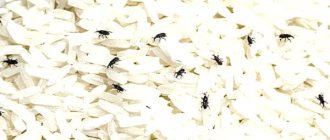In this article you will learn about a variety of ways to get rid of these parasites in cereals in your kitchen. We will also tell you what types of bugs exist, where they can live and what kind of control there is on them.
- What to do first?
- Where are they hiding?
- How do they get into the house?
- The best way to deal with bugs in the kitchen
- A more humane method
- How to prevent a new invasion
- Store products
- Types of bugs
What to do if a place of residence of bugs is discovered?
If you find a breeding ground for beetles somewhere, throw away the product. This is the best way, because even if you sift, there will be larvae in it, which will still turn into bugs. And then they will move on and occupy new territories.
We draw your attention to the fact that it is better to throw it away directly onto the street. Leave them in a trash can overnight - they will still scatter and at least one will be saved. And where there is one, there are, count, a hundred, in just a couple of weeks.
There is no need to flush it down the toilet, after all, this is a product, somehow it’s not according to Feng Shui. It’s better to take it to the trash container and the people who feed homeless animals will take the cereal.
Summarizing
Remember, food is the main source of energy and nutrients for a person, and health indicators directly depend on its quality. For cooking, you should use only high-quality, usable ingredients, and cereals with components of the vital activity of food pests are far from the best option for a healthy dish.
The methods presented in the article will help you cope with pests that have conquered the territory of your kitchen, and small tricks, in the form of folk methods for preventing the breeding of beetles, will eliminate the reappearance of insects.
Most common places
Don’t think that bugs only love tasty things: cereals and sugar.
These are such omnivorous creatures that you can find them anywhere, even in packages (sealed!) with mustard plasters.
And also in spices, including red pepper.
And since they feel great in such a place, you yourself understand that folk remedies that include something burning in their composition will not help you. But, more on that later, for now let’s identify the most likely places of their deployment, since we need to act quickly and surely.
Carefully inspect all bags of cereals. Start looking for nasties in open packages, that’s where they get in most often. If there are a lot of them there, then you can be sure that they have already managed to penetrate into closed ones, you just can’t see them yet, because the holes they gnaw are very small.
Inspect all dry provisions, as they can be not only in cereals, but also in flour, pasta, and sugar.
Maybe they don’t like salt, but look anyway, it won’t hurt. Maybe you have some special salt-eating bugs? It’s better to be on the safe side in this matter, because as soon as you leave their “nest” somewhere, you won’t even have time to blink an eye before they fill the kitchen again.
Beans are the best “house”. Why exactly the bugs love her so much is not very clear, but the fact remains. If beans are not stored in the freezer, but simply in a jar or bag, then sooner or later they will have to be eaten by beetles.
Most likely, it is in the beans that some special bugs appear, the larvae of which were already in it before, they just “sleep” until a certain moment. And as soon as they get into the heat, they immediately begin to turn into bugs, which leave dark, large spots and holes on the grains.
Or maybe some stray parasite gets into the beans from the field and then quickly multiplies? It’s not very clear, but that’s not the point.
Beans are the most vulnerable, so make it a rule to keep them in the freezer.
This is the most ideal storage place. After freezing, the quality of the grain does not change at all and it can even be planted; it germinates perfectly.
Sort through spices and medicines. As we already wrote above, bugs simply adore mustard plasters. Although it’s bitter, it’s still some kind of torment. So, look, are they there? Also, open the packages of patches, tablets and thoroughly wipe the cabinet itself. Maybe they will crawl out when you start rustling in the box. And spices - peppers, seasonings, all kinds of herbs. They could be anywhere!
Tea, coffee, dried fruits are also their favorites. Usually, it is precisely these things that housewives forget most often. They are practically invisible in the bank. They only float up when you pour the drink. This is a very disgusting sight! Therefore, look, otherwise, the hour is uneven, you will embarrass yourself by pouring tea for a guest.
Pay attention to the boxes with vegetables. Imagine, bugs even love onions. There are many posts on forums online where women say that pests have appeared even there. At the same time, the onion deteriorates and becomes soft. Therefore, don’t be lazy and inspect all the vegetables.
Look behind furniture walls and into crevices. Bugs are different. Some are cereal, and some are furniture. They are not particularly interested in provisions, but they are great at cruising around the kitchen, making crap and spoiling the mood with their appearance.
They thrive in kitchen cabinets, feeding on crumbs. In addition to kitchen furniture, open drawers in other rooms. If there are already a lot of them, then they could easily spread throughout the apartment.
Check the window sills. The kitchen window sill is especially vulnerable. Housewives often use it as an additional workplace. Therefore, there may be all sorts of tiny things in the cracks, behind which bugs will stick. And there they will make a “den” for themselves.
Take a good look at the floor. They can also have a great time there. Especially if your floors are wooden and have many small cracks. They are not so easy to spot on the floor. Here you need to either etch them with steam or wipe them with bleach. Then they jump out, and you will already know where to chase them from.
Clean out all household appliances. Surprisingly, bugs even occupy equipment. They can be found in mixers, meat grinders and even irons.
One woman on the forum wrote that she found bugs when she started ironing her blouse. Turn on the steam and they will fall out... Brrr...
So, don't forget to take a look. It will be very disappointing if you start making minced meat and there are bugs in it.
How do they get into the house?
You buy bugs. They don't start on their own and don't fly off the street. Typically, insects come with loose cereals, which are cheaper than packaged ones.
But they can also be in sealed packaging. Therefore, watch what you take. Although, to be fair, usually “sold” are larvae that cannot be seen.
Causes of pests
The question of where the bugs in cereals come from leads most housewives into a dead end, since it is really difficult to understand where the insects came from in a clean, constantly cleaned room. In most cases, the appearance of bugs is not related to the housewife’s tidiness, but is often due to factors completely independent of her.
The reasons why bugs appear in cereals or flour may be as follows:
- Failure to comply with sanitary and hygienic standards in production.
- Infection of products by insects during storage or transportation.
- The introduction of beetle larvae with bakery products into the house, followed by migration of living creatures into the cereals.
Bugs cannot appear on their own in the kitchen; this must be preceded by one of the described precedents, and the housewife brings larvae into the house with purchased products, which multiply over time and infect the existing supplies.
The best way to deal with bugs in the kitchen
So, how to get bugs out of cereals in the kitchen? There is nothing better than good old Dichlorvos.
The disgusting thing is, of course, rare, but it kills bugs on the spot. But before you treat the surfaces, find a place where you can then sit for at least half a day so that it can air out.
The procedure in this case is as follows:
- 1. Go through everything you can and take it outside (or another room)
- 2. Wipe cabinets, floors, baseboards with a damp cloth
- 3. Wash dishes and jars for cereals and pour boiling water over them (to kill the larvae)
- 4. Treat everything with Dichlorvos (necessarily wearing a mask and glasses) and retreat to visit someone
We do not advise you to call all sorts of companies that guarantee disinfection. They haven’t invented anything new, but it costs a lot of money.
No, if you have extra funds, then you can call so as not to breathe in the chemicals yourself. But, if we talk about efficiency, then there is no difference: you carry out the treatment yourself or pay people, no matter what they say, that eradicating it at home is unrealistic.
More humane ways (for pensioners)
Here we are not talking about humanity towards bugs, but about humanity towards provisions, and therefore towards pensioners. Still, if you don’t have enough money, throwing away the cereal is simply the height of madness.
Therefore, you can use this method of struggle:
- Step 1. Sift the cereal through a fine sieve and sort thoroughly.
- Step 2. Then bake it in the oven or put the bags in the freezer for 3-4 days.
- Step 3: Try to use this grain as quickly as possible.
- Step 4. Still treat the cabinets, floor and other surfaces. If you can’t use chemicals, then at least wipe it with vinegar, pour boiling water over the cracks, or you can use laundry soap (rub it and make a soap solution). You can also make a solution of boric acid.
- Step 5. Be sure to wash the dishes, as there may be larvae there.
After you put the grains back in the box, you can place “traps” there. Pour sunflower oil into the caps and the remaining bugs will certainly taste this treat. And they will drown in it, and you will simply fly out this oil and that’s it.
Then, you can place bay leaves and garlic in the cabinets. We don’t guarantee that this is very effective and will help remove the bugs forever, but it calms the soul.
How to prevent a new invasion?
There's no way you can prevent this. Little depends on cleanliness; rather, it depends on attentiveness.
The only thing that can be recommended is to keep cereals in hermetically sealed glass jars, specially designed for storing bulk products (here is a good article on this topic).
Although this is not a panacea, at least then they won’t scatter to other places.
Also, be sure to close the packages with spices, even with regular paper clips.
In general, there is only one prevention: just try not to buy anything for future use. It’s probably not 1917, and you can go to the store at any time. It is better to buy less and a little more expensive than a lot, cheaply, but send half to feed the yard dogs.
How do uninvited guests appear in a living space?
You purchase kitchen pests from the store yourself. Only moths can fly in. All other insects come to their new place of residence in bags of food. If the package of cereals is transparent, then carefully study what you are going to the checkout with. In addition, new guests may appear in your kitchen from neighbors through ventilation, holes and cracks.
What store-bought insect repellents are there?
We have already written what works best and what exactly can be used to get rid of bugs. But, in addition to such means, there are also all sorts of traps, for example, pheromones. You can buy a couple and place them for prevention purposes and to attract those individuals that have survived the main treatment.
Using only traps is unwise and expensive. They do not act as quickly as we would like, judging by the reviews on the Internet. And as long as there are bugs in the kitchen, the cereal will become unusable.
Why do they start
Various insects enter the kitchen from the market, food kiosk or supermarket, where dried fruits, beans, and pasta are sold. The bugs start:
- due to improper grain processing at the enterprise;
- in case of violation of the storage conditions of the goods;
- in the absence of sanitary control of the content of cereals.
Products infested with insects are sometimes imported by unscrupulous suppliers. Bugs appear in stores when the air is too dry, there is no ventilation, or sanitary standards are not observed.
Types of bugs
And finally, let us tell you what pests there are and what they are called. Perhaps you can identify them from the photo and then it will be easier to choose chemicals in the store if there are bugs.
| The Surinamese mucoed is light-colored, with long horns. |
| Bread borer - small brown bugs, the most common type. They are also called the Pharmacy Beetle and the Kozheed. |
| Flour beetle - looks like a real beetle, with horns, but very small. |
| Red mucous eater - how to deal with them is written above. It is just as difficult to remove these bugs as any other. |
| Rice weevils look like ants from afar. |
Food moth is a separate case. The tips given above will not always help; you will have to buy products that hang in the kitchen, because these are flying insects. We can only wish you one thing - that our advice will come in handy for a very long time!
If you have any related questions, please ask them in the comments.
Prevention and advice
Bugs in the kitchen spoil not only food, but also the mood of all family members. In order not to get upset in the future and not waste energy on destroying uninvited guests, it is better to carry out prevention.
5 tips on how to prevent bugs from appearing in the kitchen:
- Carefully inspect the goods you buy in stores. If the packaging is transparent, then try to see the contents through it as much as possible. Do not buy suspicious or low-quality products.
- Place all grains for storage into clean, dry, sealed containers.
- Do not keep bags of sugar and flour at home.
- Clean your kitchen regularly.
- Seal all cracks on furniture and floors.











